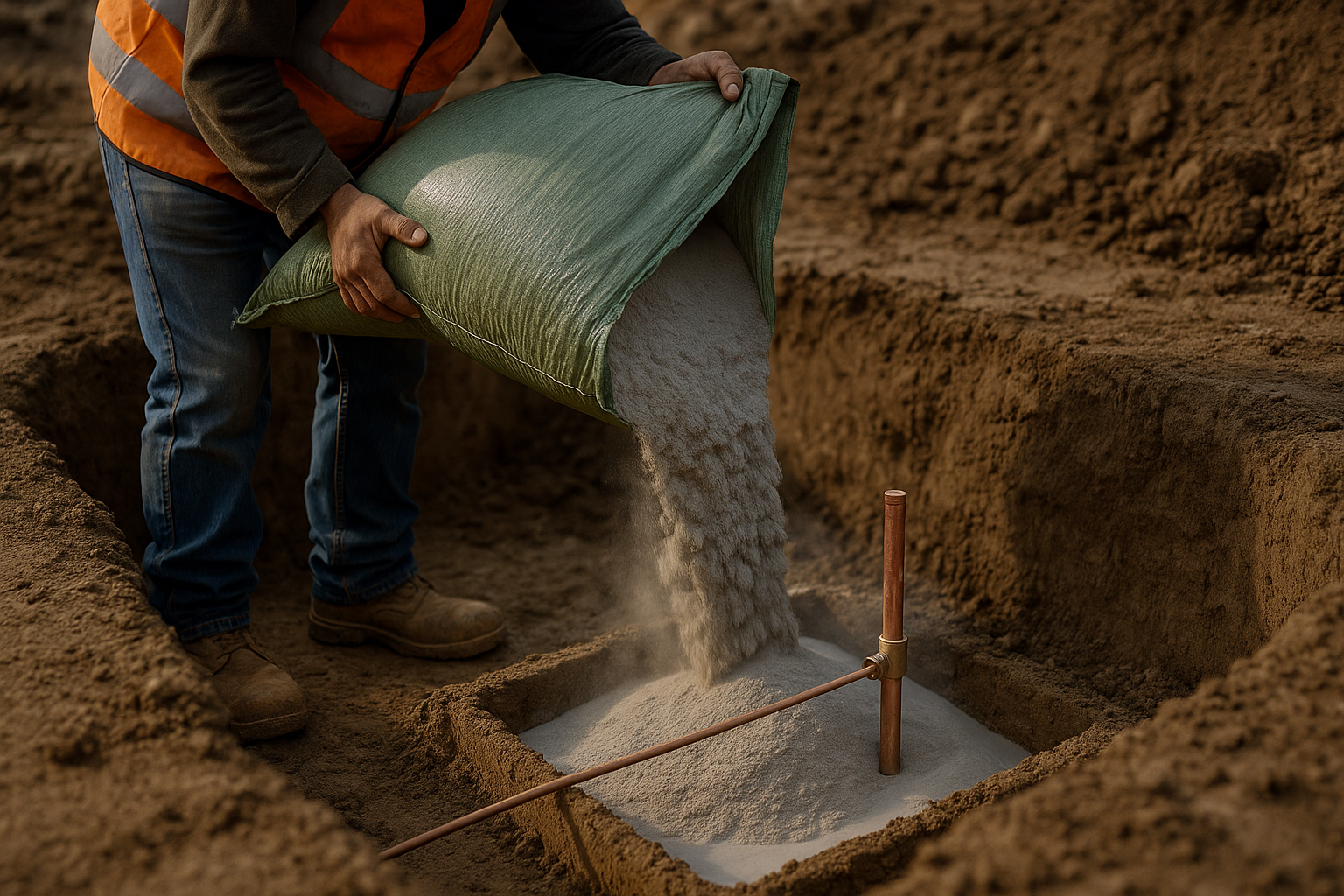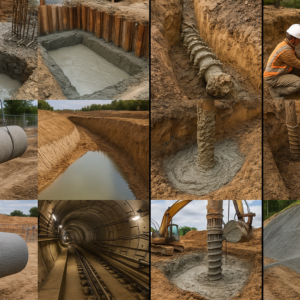Electrical safety forms the backbone of modern infrastructure, from towering telecommunication systems to sprawling industrial complexes. At the heart of these protective measures lies a naturally occurring clay mineral that quietly safeguards millions of installations worldwide: earthing bentonite.
This specialized material has become the go-to solution for electrical grounding systems across the globe. But what makes this humble clay so essential for electrical safety? Let’s break it down.
Understanding Earthing Bentonite: The Basics
Earthing bentonite is a naturally occurring clay mineral composed primarily of montmorillonite, a sodium-based material with remarkable properties. When mixed with water, this clay swells to many times its original volume, creating a moisture-rich environment around electrical grounding components.
The material functions as a backfill compound in earthing systems, surrounding earth electrodes such as copper rods or earth mats. By creating an interface between the electrode and the surrounding soil, bentonite dramatically reduces electrical resistance and ensures safer operations.
How Does Bentonite Work in Grounding Systems?
The science behind bentonite’s effectiveness lies in its unique physical and chemical properties. This clay can absorb up to five times its weight in water, creating a consistently conductive medium around earth electrodes. When rainfall or groundwater makes contact with the installed bentonite, the material swells and maintains moisture levels even during dry periods.
This moisture retention directly impacts electrical conductivity. Dry soil typically exhibits high electrical resistance, making it difficult for fault currents to dissipate safely. Bentonite solves this problem by maintaining a low-resistance pathway between the electrode and the earth, regardless of seasonal variations or soil conditions.
Primary Earthing Bentonite Uses in 2025
The applications of earthing bentonite have expanded significantly as electrical infrastructure becomes more complex. Here are the main areas where this material proves indispensable.
Electrical Substations and Power Distribution
High-voltage electrical substations rely on robust grounding systems to protect equipment and personnel. Bentonite backfill ensures consistent ground resistance values across varying soil conditions. Power distribution networks use this material to create reliable safety pathways that can handle fault currents during electrical anomalies.
The ability to reduce soil resistivity by up to 80% makes bentonite the preferred choice for these critical installations. This reduction translates directly into safer working conditions and better equipment protection.
Telecommunication Tower Grounding
Telecommunication towers face constant exposure to lightning strikes and electrical surges. These tall structures require grounding systems that can rapidly dissipate massive electrical charges to prevent equipment damage and service interruptions.
Bentonite creates a low-resistance connection between the tower’s grounding system and the earth, protecting sensitive communication equipment from voltage spikes. The material’s long-term stability means fewer maintenance requirements and consistent protection over the structure’s lifespan.
Industrial Facilities and Manufacturing Plants
Manufacturing operations depend on uninterrupted electrical supply and safe working conditions. Industrial grounding systems using bentonite provide reliable protection against electrical faults that could halt production or endanger workers.
The material works equally well in various industrial settings, from chemical processing plants to automotive manufacturing facilities. Its compatibility with different soil types makes it a versatile solution for facilities across diverse geographical locations.
Residential and Commercial Building Safety
Modern buildings incorporate sophisticated electrical systems requiring proper grounding for safety. Bentonite earthing compounds ensure that residential complexes, shopping centers, and office buildings maintain safe electrical installations that meet regulatory standards.
The material’s ability to maintain consistent performance across seasons makes it particularly valuable in regions with extreme weather variations. Whether facing monsoon rains or extended dry periods, bentonite-enhanced grounding systems maintain their protective capabilities.
Confused about which bentonite is best for pond sealing — sodium or calcium? Read this blog to find out which one gives better results!
Why Bentonite Remains the Preferred Choice in 2025
Several factors contribute to bentonite’s continued dominance in the grounding industry.
Superior Moisture Retention Properties
Unlike synthetic alternatives, bentonite naturally attracts and holds water molecules. This characteristic ensures consistent electrical conductivity around ground electrodes throughout the year. The clay’s swelling properties create an enlarged contact area with surrounding soil, further reducing resistance.
Environmental Safety and Sustainability
As environmental concerns shape industrial practices, bentonite offers a naturally occurring, non-toxic solution for grounding applications. The material poses no risk to soil quality or groundwater, making it acceptable for use in environmentally sensitive areas.
Local authorities increasingly favor bentonite over chemical alternatives that may harm ecosystems. This environmental compatibility ensures that grounding installations can proceed without lengthy approval processes or environmental impact assessments.
Cost-Effectiveness and Longevity
Initial installation costs remain reasonable, and the material’s long service life reduces maintenance expenses. Bentonite installations typically maintain their effectiveness for many years without requiring replacement or enhancement, providing excellent value over the system’s operational lifetime.
Compatibility with Various Soil Conditions
Rocky terrain, sandy soil, or clay-heavy ground all present unique challenges for grounding systems. Bentonite adapts to these varied conditions, providing consistent performance regardless of the surrounding soil composition. This versatility eliminates the need for site-specific solutions, simplifying installation processes.
Installation Methods for Earthing Bentonite
Proper installation determines the effectiveness of bentonite in grounding systems. Here’s how professionals approach the process.
Vertical Earth Rod Installation
For vertical electrode installations, workers drill boreholes to the required depth, typically ranging from 2 to 6 meters depending on soil conditions and resistance requirements. The earth rod goes into the hole, and workers fill the surrounding space with a bentonite mixture.
The mixing ratio typically involves combining bentonite powder with water to achieve a slurry consistency. This mixture flows easily around the electrode, ensuring complete contact. As the bentonite absorbs moisture and swells, it creates a tight seal around the rod.
Horizontal Earth Conductor Systems
Horizontal grounding systems use trenches to lay earth conductors at specified depths. Workers place a layer of bentonite along the trench bottom before positioning the conductors. Additional bentonite covers the conductors, creating an encapsulating layer that maintains moisture around the entire conductor length.
This method works particularly well for large installations requiring extensive grounding networks, such as substations or industrial facilities.
Strip Earthing Applications
Strip electrodes benefit from bentonite backfill through improved contact with surrounding soil. The installation process mirrors horizontal conductor methods, with bentonite layers above and below the earth strips ensuring consistent conductivity along their entire length.
Key Benefits of Using Earthing Bentonite
The advantages of bentonite in grounding applications extend beyond simple resistance reduction.
Significant Resistance Reduction
Research shows that bentonite can lower soil resistivity by up to 80%, translating to substantial improvements in grounding system effectiveness. This reduction means faster fault current dissipation and better protection for equipment and personnel.
Extended Surface Contact Area
When bentonite swells, it increases the effective surface area of ground electrodes. A larger contact area with surrounding soil creates more pathways for current flow, further reducing overall system resistance.
Consistent Performance Across Seasons
Seasonal moisture variations significantly impact soil conductivity. Dry summer months can increase soil resistance dramatically, potentially compromising grounding system effectiveness. Bentonite maintains moisture levels around electrodes year-round, ensuring consistent protection regardless of weather conditions.
Non-Corrosive Properties
Unlike some chemical backfill materials containing sulfur or other corrosive elements, bentonite remains chemically neutral. This property protects copper earth electrodes from degradation, extending system lifespan and maintaining performance over time.
Curious about OCMA DFCP 4 Bentonite Powder? Read this blog to discover what it is and how it’s used across various industrial applications!
Sourcing Quality Earthing Bentonite
The effectiveness of bentonite in grounding applications depends heavily on material quality. Not all bentonite offers the same properties, and selecting the right grade ensures optimal performance.
CMS Industries specializes in manufacturing high-grade bentonite powder specifically formulated for electrical earthing applications. As an ISO 9001:2015 certified company with production facilities strategically located in Gujarat, India, they supply bentonite that meets international standards for grounding applications.
Quality bentonite for earthing should exhibit high sodium content, excellent swelling capacity, and appropriate particle size distribution. These characteristics ensure proper moisture retention and conductivity improvement in grounding systems.
Bentonite vs. Alternative Grounding Materials
While several backfill materials exist for grounding applications, bentonite maintains distinct advantages.
Chemical Enhancement Compounds
Synthetic chemical compounds can reduce soil resistance but often raise environmental concerns. These materials may leach into groundwater or degrade soil quality over time. Bentonite’s natural origin eliminates these concerns while providing comparable or superior performance.
Conductive Concrete
Specialized conductive concrete offers permanence but lacks bentonite’s adaptability. Once installed, concrete cannot expand or contract with moisture variations, potentially creating gaps as soil conditions change. Bentonite’s swelling properties maintain consistent contact with surrounding soil.
Carbon-Based Backfills
Carbon compounds can contain impurities harmful to copper electrodes. Sulfur and other elements present in some carbon-based materials accelerate corrosion, reducing system lifespan. Bentonite’s chemical neutrality makes it safer for long-term applications.
Standards and Best Practices for 2025
Modern grounding installations follow specific standards to ensure safety and effectiveness.
Regulatory Compliance
Electrical codes worldwide specify maximum allowable resistance values for grounding systems. Bentonite helps installations meet these requirements across diverse soil conditions. Compliance with IEEE standards and local regulations ensures that grounding systems provide adequate protection.
Testing and Verification
After installation, professionals test grounding systems to verify resistance values meet specifications. These tests confirm that bentonite backfill achieves the desired performance levels. Regular maintenance testing ensures continued effectiveness throughout the system’s operational life.
Professional Installation Requirements
While bentonite itself is straightforward to use, proper installation requires expertise. Professional installers understand mixing ratios, placement techniques, and compaction requirements that maximize material effectiveness. Working with experienced contractors ensures that grounding systems perform as intended.
Future Applications and Developments
As electrical infrastructure evolves, earthing bentonite uses continue to expand.
Renewable Energy Installations
Solar farms and wind turbine installations require extensive grounding systems to protect expensive equipment from lightning strikes and electrical faults. Bentonite’s reliability and environmental safety make it ideal for these applications, particularly in remote locations where maintenance access is limited.
Data Center Protection
The explosive growth of data centers has created new demands for robust grounding systems. These facilities house sensitive equipment requiring protection from electrical disturbances. Bentonite-enhanced grounding provides the low-resistance pathways necessary for reliable data center operations.
Electric Vehicle Charging Infrastructure
The rollout of electric vehicle charging networks introduces new grounding challenges. Fast-charging stations require grounding systems capable of safely handling high-power electrical systems. Bentonite helps these installations meet safety standards while adapting to various location conditions.
Maintenance and Long-Term Performance
Proper maintenance extends bentonite grounding system effectiveness.
Periodic Resistance Testing
Regular testing identifies any performance degradation before it becomes problematic. Annual resistance measurements help track system condition and identify when maintenance might be necessary.
Moisture Management
While bentonite naturally retains moisture, extended drought conditions in some regions might require periodic watering to maintain optimal performance. This simple maintenance step ensures continued effectiveness during unusually dry periods.
System Upgrades and Expansion
As facilities grow or electrical loads increase, grounding systems may require enhancement. Adding bentonite around existing electrodes or installing additional ground rods with proper backfill maintains system adequacy as requirements change.
Connect with Quality Bentonite Suppliers
Selecting the right bentonite supplier ensures your grounding system performs optimally. CMS Industries offers premium-grade bentonite powder specifically formulated for electrical earthing applications, backed by ISO certification and decades of manufacturing expertise.
Their strategically located production facilities near major ports enable efficient delivery to projects across India and international markets. With monthly production capacity exceeding 9,000 metric tons, they supply projects of any scale while maintaining consistent quality standards.
Whether you’re planning a new electrical installation, upgrading existing grounding systems, or seeking reliable materials for ongoing projects, CMS Industries provides the earthing bentonite that electrical professionals trust. Visit their website to learn more about their product specifications and how they can support your grounding system requirements.
Frequently Asked Questions
Q1: What is the typical resistance reduction when using earthing bentonite?
Earthing bentonite can reduce soil resistivity by 60-80% depending on soil conditions and installation methods. This significant reduction translates to safer grounding systems with better fault current dissipation capabilities. The exact reduction varies based on original soil composition, moisture content, and bentonite quality used in the installation.
Q2: How long does bentonite maintain its effectiveness in grounding systems?
Quality bentonite installations typically maintain effectiveness for 10-15 years or longer with minimal maintenance. The material’s natural moisture retention properties and swelling characteristics ensure consistent performance throughout its service life. Periodic testing helps verify continued effectiveness and identifies any rare situations requiring enhancement.
Q3: Can bentonite be used in all soil types for grounding applications?
Yes, bentonite adapts to virtually all soil conditions including rocky terrain, sandy soil, and clay-heavy ground. Its ability to retain moisture and create low-resistance pathways works across diverse geological conditions. This versatility makes it suitable for installations in varied geographical locations without requiring site-specific alternative materials.
Q4: Is earthing bentonite environmentally safe for long-term installation?
Bentonite is a naturally occurring clay mineral that poses no environmental hazards to soil or groundwater. Its non-toxic composition makes it acceptable for use in environmentally sensitive areas without special precautions. Unlike chemical alternatives, bentonite doesn’t leach harmful substances or degrade soil quality over time.
Q5: What is the proper mixing ratio for bentonite in earthing applications?
While specific ratios vary by manufacturer recommendations, typical mixtures use 1 part bentonite powder to 4-6 parts water to create a slurry consistency. The mixture should flow easily around electrodes while maintaining enough density to stay in place during installation. Professional installers adjust ratios based on specific site conditions for best results.







